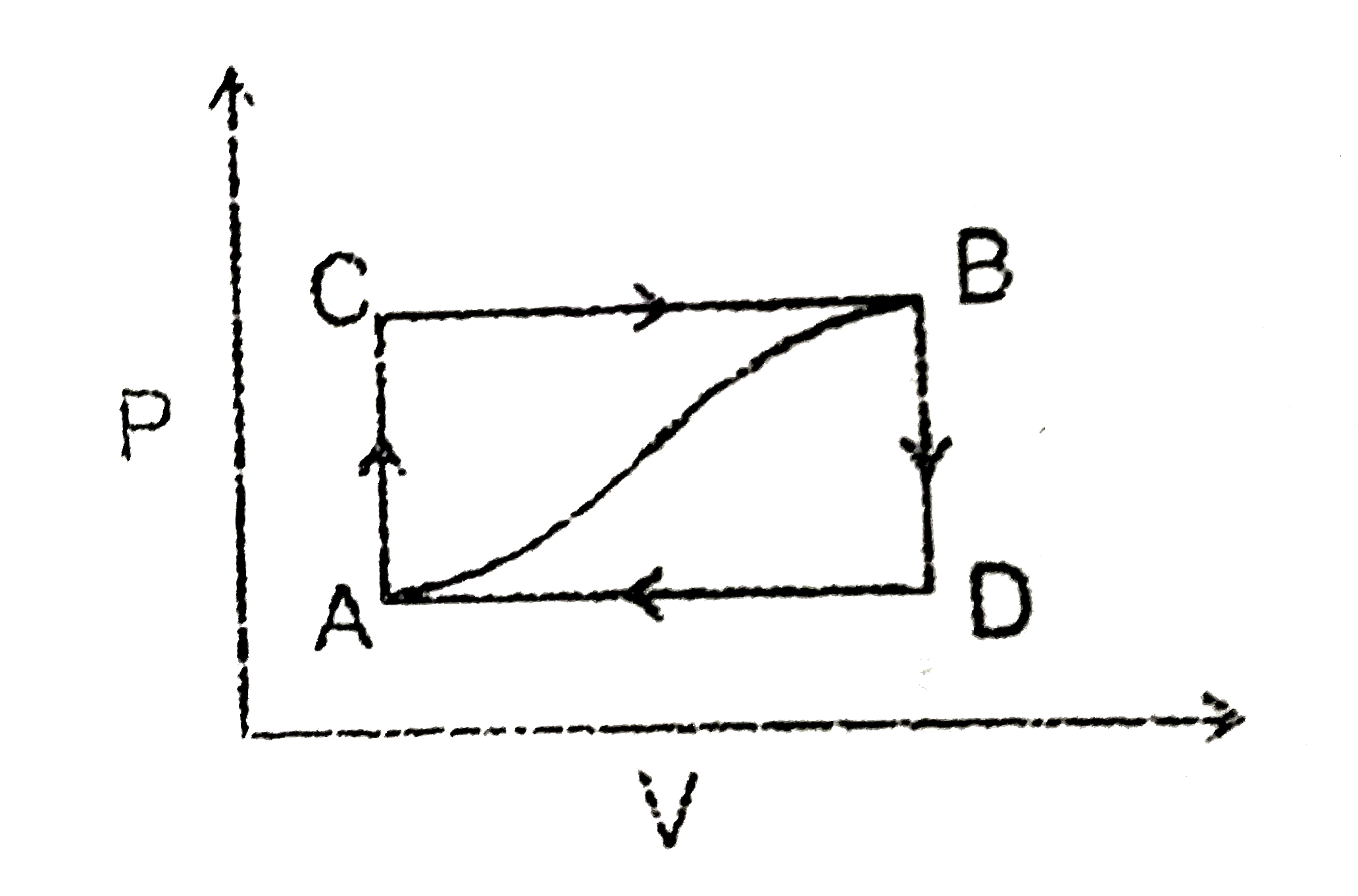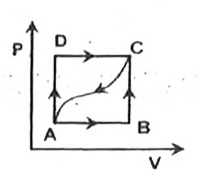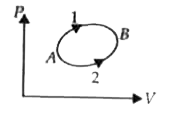A system goes from P to Q by two different paths in the P -V diagram as shown in figure. Heat given to the system in path 1 is 1000 J. The work done by the system along path 1 is more than path 2 by 100 J. What is the heat exchanged by the system in path 2 ?
 Solution in Gujrati
Solution in Gujrati
For path 1: Heat given Q1=+1000 J
Work done = W1
For path 2: Work done W2=W1−100J
Heat given Q2= ?
As change in internal energy between two states for different path is same.
∴ΔU=Q1−W1=Q2−W2
∴1000−W1=Q2−(W1−100)
∴Q2=1000−W1+W1−100
∴Q2=900 J
Topper's Solved these Questions
- THERMODYANMICS BOOK - KUMAR PRAKASHANCHAPTER - THERMODYANMICS EXERCISE - Section-D Ncert Exemplar Solution (Short Answer )
6 Videos
- THERMODYANMICS BOOK - KUMAR PRAKASHANCHAPTER - THERMODYANMICS EXERCISE - Section-D Ncert Exemplar Solution (Long Answer )
5 Videos
- THERMODYANMICS BOOK - KUMAR PRAKASHANCHAPTER - THERMODYANMICS EXERCISE - Section-D Ncert Exemplar Solution (MCQs More than one option )
5 Videos
- THERMAL PROPERTIES OF MATTERBOOK - KUMAR PRAKASHANCHAPTER - THERMAL PROPERTIES OF MATTEREXERCISE - Question Paper (Section - D) (Answer following in brief :) Each carry 4 marks
1 Video
- UNITS AND MEASUREMENTBOOK - KUMAR PRAKASHANCHAPTER - UNITS AND MEASUREMENTEXERCISE - Section -F (Questions from Module )
20 Videos
Similar Questions
Consider a Carnot's cycle operating between T1 = 500 K and T2 = 300 K producing 1 kJ of mechanical work per cycle. Find the heat transferred to the engine by the reservoirs.
View SolutionConsider a P-V diagram in which the path followed by one mole of perfect gas in a cylindrical container is shown in figure.

(a) Find the work done when the gas is taken from state 1 to state 2.
(b) What is the ratio of temperature T1T2 if V2=2V1 ?
(c) Given the internal energy for one mole of gas at temperature T is 32RT, find the heat 2 supplied to the gas when it is taken from state 1 to 2, with V2=2V1
View SolutionWhich of the processes described below are irreversible ?
View SolutionIn an experiment on the specific heat of a metal, a 0.20 kg block of the metal at 150∘C is dropped in a copper calorimeter (of water equivalent 0.025 kg) containing 150 cm3 of water at 27∘C. The final temperature is 40∘C. Compute the specific heat of the metal. If heat losses to the surroundings are not negligible, is your answer greater or smaller than the actual value for specific heat of the metal ?
View SolutionIf the error in measurement of radius of a shpere is 2% then the error in determination of volume of the sphere will be …………
View SolutionA system goes from P to Q by two different paths in the P-V diagram as shown in (figure). Heat given to the system in path 1 is 1000J . The work done by the system along path 1 is more than path 2 by 100J . What is the exchange by the system in path 2?
View SolutionA system is taken from state A to state B along two different paths 1 and 2 . The heat absorbed and work done by the system along these two paths are Q_(1) and W_(1) and W_(2) respectively.
View SolutionA system goes from P to Q by two different paths in the p−V diagram as shown in figure. Heat given to the system in path 1 is 1000 J. The work done by the system along path 1 is more than path 2 by 100 J. What is the heat exchanged by the system in path 2 ?

View SolutionA system goes from A to B by two different paths in the P-V diagram as shown in figure Heat given to the system in path 1 is 1100 j, the work done by the system along path 1 is more than path 2 by 150 J. The heat exchanged by the system in path 2 is

View SolutionWhen a system is taken from state A to state B along path ACB as shown in figure below, 80J of heat flows into the system and the system does 30J of work.

How much heat flows into the system along path ADB if the work done by the system is 10J:
View SolutionA gas can be ken from A to B via two different processes ACB and ADB. When path ACB is used 60 J of heat flows into the system and 30 J of work is done by the system. If path ADB is used work done by the system is 10 J. The heat Flow into the system in path ADB is :

View SolutionA gas can be taken from A to B via two different processes ACB and ADB. When path ACB is used 60 J of heat flows into the system and 30 J of work is done by the system. If path ADB is used work done by the system is 10 J. The heat Flow into the system in path ADB is:
View SolutionIn the adjoinign P-V diagram, 100 J of heat is given in taking a system from A to C along the path ADC and 50 J of work is done by system in this path.
a. If the work done by the suystem is 15 J along the path ABC, then how much heat is to be given in taking the system from A to C along ABC?

b. How much heat will be absorbed or given out if the work done on the system along the curved path from CA to A is 15 J?
c. If UB−UA=40J, then how much heat will be absorbed in each process AB and BC?
View SolutionWhen a system is taken from stata a to state b along the path acb as shown in figure, 60 J of heat flows into the system and 30 J of work is done by the system. Along the path adb, if the work done by the system is 10 J, heat flow into the system is
View SolutionA system goes from P to Q by two different paths in the P-V diagram as shown in figure. Heat given to the system in path 1 is 1100 J, the work done by the system along path 1 is more than path 2 by 150 J. The heat exchanged by the system in path 2 is

View Solution
